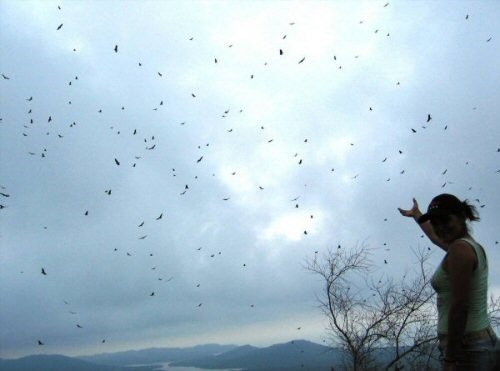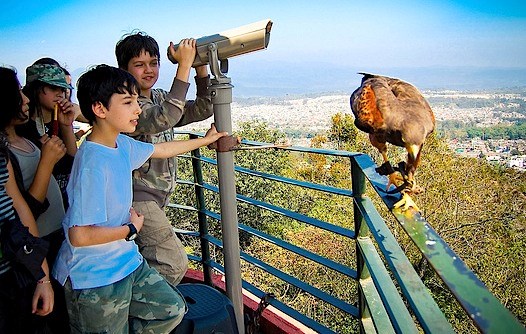The Veracruz River of Raptors Success Story
Posted on September 02, 2020 in Special Projects

By Rebekah Smith, Science-Education Outreach Coordinator
As raptor migration occurs all over the continent this autumn, determined Hawk Mountain staff and volunteers continue the bi-annual count, despite the challenges humanity has collectively faced in 2020. Although the world is full of uncertainties, we can still depend on Hawk Mountain counters observing some of the same raptors that will later pass through the largest migration count site on the globe, Veracruz River of Raptors in eastern Mexico. Not only is Hawk Mountain connected to Veracruz through the raptors that migrate each fall, but it is also connected through a rich raptor conservation success story that began in the 1980s and has continued to be successful throughout the decades.
The large numbers of migrating hawks flying over Veracruz began gaining attention from ornithologists starting in the 1960s and 70s. In 1987, 33 years ago, a young Ernesto Ruelas Inzunza and a group of his college friends began the observation of the migratory birds of prey in Veracruz, Mexico. They gave a presentation of their findings at the Raptor Research Foundation meeting in the city of Veracruz, catching the eye of Jim Bednarz, Director of Science at Hawk Mountain Sanctuary. Jim invited Ernesto to Hawk Mountain to study as a trainee during the fall of 1990.
That fall, Jim Bednarz moved on from Hawk Mountain and Laurie Goodrich became the interim Director of Science in his place. Ernesto met with Laurie, Jim Brett, and Steve Hoffman, Director of HawkWatch International at the time, and proposed a collaboration to conduct the first scientific daily count of migrating raptors in Veracruz. All agreed, and a new partnership was founded. Each organization contributed a small amount of funding towards the Veracruz effort. Together, they were able to sponsor one experienced counter from HawkWatch International and a former Hawk Mountain trainee Jim Zelenak, to travel there and assist Ernesto with the count and with training Mexican biologists.
The first count, during the spring of 1991, lasted a total of 45 days and resulted in more than 800,000 migrating hawks counted. At this point, they had four different count sites spaced 15 km apart on an East to West transect across the migration corridor. After the awe-inspiring results of the first spring count, the team decided that they should study migration in the fall as well. Laurie, Ernesto, and Cynthia Lenhart, Director of Hawk Mountain at the time, wrote a successful grant proposal to the National Fish and Wildlife Foundation and were awarded funds for continuing the counting of raptors and waterbirds in Veracruz. Subsequent grants obtained from the Foundation and the US Fish and Wildlife Service funded several more years of migration monitoring, study of roosting sites, and the launch of a new environmental education initiative focused on raptors. Ernesto helped to form the first chapter of Pronatura AC in Veracruz, becoming its first director and giving the project a firm organizational footing.
The first autumn count in Veracruz, Mexico occurred in 1992. Hawk Mountain sent another experienced counter southbound, former trainee Jeanne Tinsman, to help train local Mexican counters. By mid-September, after only two weeks of counting, the Veracruz count team reported counting their millionth bird. By the end of the first fall count, they had tallied 2.5 million raptors. Laurie recollected that these numbers astounded her, especially when Hawk Mountain had only observed its millionth migrant in October 1992 after 57 years of counting. During this time, the Veracruz counters had to develop a new flock estimation technique for counting huge flocks of birds since it was impossible to count each individual during peak days. Their technique is still used today. Due to their need to have three counters on site daily, the team had to reduce their transect to the two sites which had proven to observe the highest concentration of raptors during migration, Cardel and Chichicaxtle.
Education and public outreach were a primary goal right from the start. The team created posters and brochures about the migration and dispersed them during fall, 1992. In 1993, the Hawk Mountain Director of Education, Sharon Gaughan, worked with Mexican educators and former Hawk Mountain trainees, Flor Galán and Evodia Silva, to develop programs and a manual for school children in the central coast of Veracruz that are still used today. Sharon and Hawk Mountain staff helped train several other education trainees over the years to become educators in Veracruz, including Yumei Cabrera, who was a Hawk Mountain trainee in 1999 and is now the Pronatura Education Specialist leading education efforts.
By the mid-1990s Hawk Mountain, HawkWatch International, and Pronatura began searching for long-term funding that would make the project truly sustainable. They worked together to design an ecotourism program and birding tour that would bring a profit to the project and stimulate the local economy. Laurie and Sharon led one of the first birding tours to Veracruz in 1994 and Laurie continues to lead them now, encouraging ecotourism and helping both Pronatura and the Veracruz community to reap the benefits of sharing their skies with a natural wonder. Today, their ecotourism program is a key part of funding for the River of Raptors Project. Laurie will be leading the next tour to Veracruz in autumn 2021. Visit hawkmountain.org/ecotours for more information.
Now, Veracruz River of Raptors observes an average of 4.5 million birds during the autumn migratory season from the two sites. The most numerous migrants are turkey vultures, broad-winged hawks, Swainson’s hawks, and Mississippi kites. Hawk Mountain has served as a role model for the founding and success of this sustainable raptor count site and we continue to collaborate with this important global raptor conservation project.
Veracruz, like Hawk Mountain, provides scientists with the unique opportunity to monitor many different species in one place including raptors, waterbirds, and dragonflies. Veracruz has become a key site for capacity building in raptor conservation for Spanish speaking audiences and a livelihood alternative for many young people living in local communities.Since the start of the Veracruz River of Raptors project, we have learned that 90% of Swainson’s hawks are flying through Veracruz, over the eastern Gulf of Mexico, even though they are known to nest in the far northwestern part of the continent. This has given us a much more accurate estimate of Swainson’s hawk population numbers and migration patterns, which will help to inform policy and decisions about raptor protection.These beneficial aspects make Veracruz a linchpin in the fabric of global conservation efforts.

In 2006, the Veracruz River of Raptors partners achieved a benchmark success by raising enough funding to construct the first nature center and bird observatory in the region, following a pattern of community outreach and education similar to that which Hawk Mountain Sanctuary has achieved. Since then, the presence of Pronatura and the migration site in the community has broadened as each year. The project has been crucial to the protection of natural areas in the region used as stopover for migratory birds. Numbers of Mexicans from all around Mexico visiting Veracruz River of Raptors to watch birds migrate continue to increase. Veracruz River of Raptors also hosts an annual raptor festival during the second week of October, attracting both local residents and ecotourists alike. Each year, the Bird Observatory receives visitors from the United States, Canada, Europe, Japan, South America,and Africa.
Hawk Mountain trainees are the future generation of raptor conservationists and are a proven source of successful global raptor conservation connectedness. Hawk Mountain continues to accept upcoming conservationists who have been inspired by the River of Raptors into the conservation trainee program. The Education Specialist at Veracruz River of Raptors, Yumei, now inspires and trains the next generation of raptor conservationists, who sometimes become Hawk Mountain trainees themselves. Kashmir Wolf, the Veracruz River of Raptors Coordinator, is a former Hawk Mountain trainee as well. Ernesto Ruelas left Pronatura in the mid-2000s to obtain his Ph.D. He still lives in nearby Jalapa, teaching at the university and bringing his students to assist with raptor migration counts and banding.
Veracruz River of Raptors has become an outstanding raptor conservation success story because of the hard work and collaboration among partners at Hawk Mountain, HawkWatch International, and Pronatura-Veracruz. Since the founding of the Veracruz watch site, many other partners that have joined the flock as well. The model exemplified by both Hawk Mountain and Veracruz River of Raptors has become timeless, representing the mutual benefits that humans and raptors can provide one another. They also demonstrate the value of sites like these for global collaboration and conservation progress.
Due to travel restrictions as a result of COVID-19, Pronatura-Veracruz River of Raptors has a special need for donations this year. They use donations to operate education, monitoring, and banding programs, and still need approximately $10,000 to complete their autumn 2020 migration season. If you would like to help support the important migratory raptor work done at Pronatura Veracruz, please consider donating to their GoFundMe page at charity.gofundme.com/o/en/campaign/river-of-raptors-in-action. For more information about Pronatura and Veracruz River of Raptors visit www.pronaturaveracruz.org.